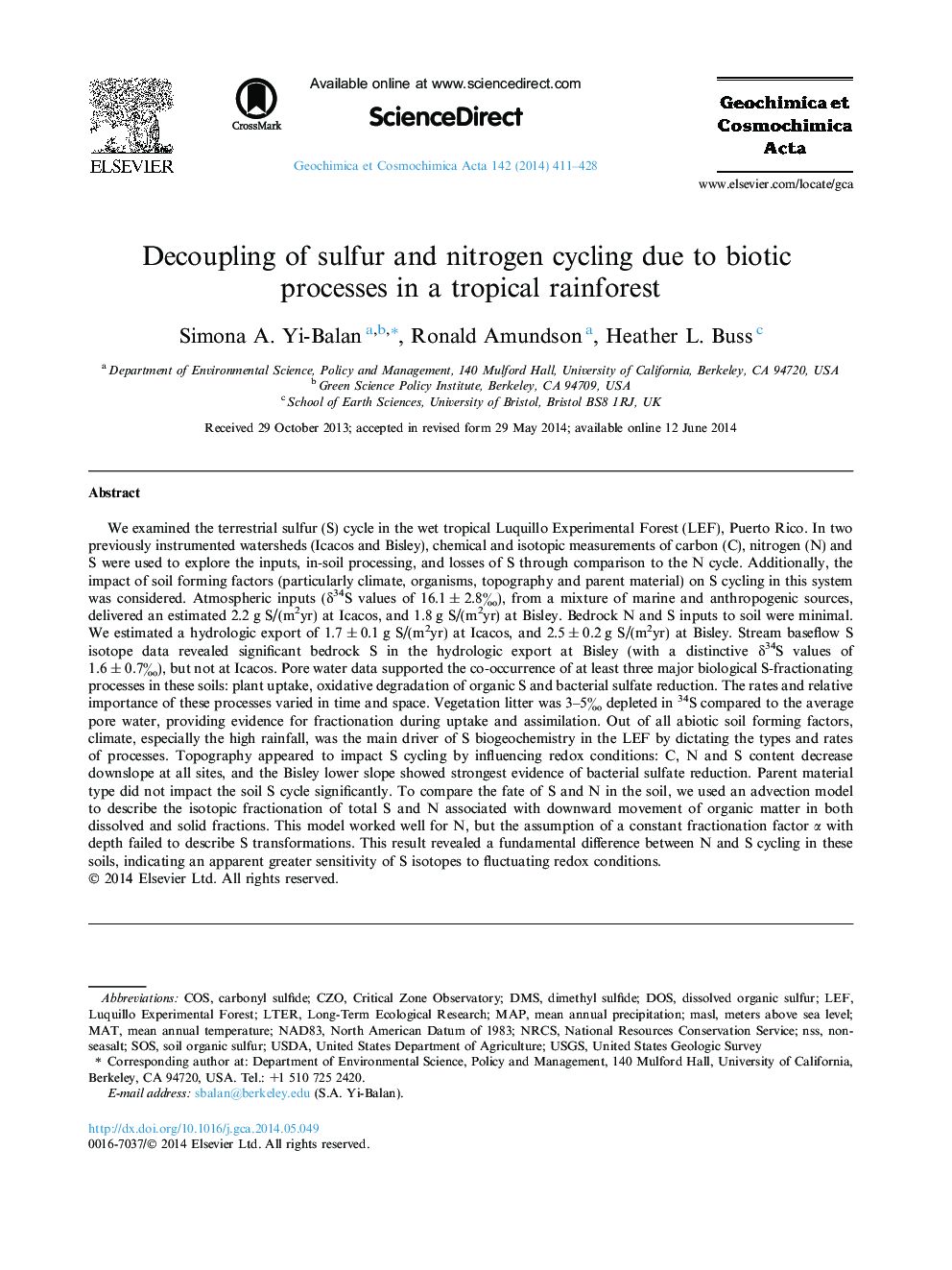| کد مقاله | کد نشریه | سال انتشار | مقاله انگلیسی | نسخه تمام متن |
|---|---|---|---|---|
| 6438471 | 1638015 | 2014 | 18 صفحه PDF | دانلود رایگان |
عنوان انگلیسی مقاله ISI
Decoupling of sulfur and nitrogen cycling due to biotic processes in a tropical rainforest
ترجمه فارسی عنوان
جدا کردن گوگرد و نیتروژن دوچرخه سواری به دلیل فرایندهای زیست محیطی در یک جنگل بارانی استوایی
دانلود مقاله + سفارش ترجمه
دانلود مقاله ISI انگلیسی
رایگان برای ایرانیان
کلمات کلیدی
Critical Zone ObservatoryNRCSDMSCOSLTERNSSSOSUSGSUSDALong-term ecological research - تحقیقات زیست محیطی درازمدتCZO - جلوLuquillo experimental forest - جنگل آزمایشی لوکیلوDOS - داسUnited States Department of Agriculture - دپارتمان کشاورزی ایالات متحدهDimethyl sulfide - دی متیل سولفیدLef - لفMat - ماتMASL - ماسکmeters above sea level - متر بالاتر از سطح دریاmean annual precipitation - میانگین بارندگی سالانهmean annual temperature - میانگین دما سالانهmap - نقشهCarbonyl sulfide - کربن سولفید
موضوعات مرتبط
مهندسی و علوم پایه
علوم زمین و سیارات
ژئوشیمی و پترولوژی
چکیده انگلیسی
We examined the terrestrial sulfur (S) cycle in the wet tropical Luquillo Experimental Forest (LEF), Puerto Rico. In two previously instrumented watersheds (Icacos and Bisley), chemical and isotopic measurements of carbon (C), nitrogen (N) and S were used to explore the inputs, in-soil processing, and losses of S through comparison to the N cycle. Additionally, the impact of soil forming factors (particularly climate, organisms, topography and parent material) on S cycling in this system was considered. Atmospheric inputs (δ34S values of 16.1 ± 2.8â°), from a mixture of marine and anthropogenic sources, delivered an estimated 2.2 g S/(m2yr) at Icacos, and 1.8 g S/(m2yr) at Bisley. Bedrock N and S inputs to soil were minimal. We estimated a hydrologic export of 1.7 ± 0.1 g S/(m2yr) at Icacos, and 2.5 ± 0.2 g S/(m2yr) at Bisley. Stream baseflow S isotope data revealed significant bedrock S in the hydrologic export at Bisley (with a distinctive δ34S values of 1.6 ± 0.7â°), but not at Icacos. Pore water data supported the co-occurrence of at least three major biological S-fractionating processes in these soils: plant uptake, oxidative degradation of organic S and bacterial sulfate reduction. The rates and relative importance of these processes varied in time and space. Vegetation litter was 3-5â° depleted in 34S compared to the average pore water, providing evidence for fractionation during uptake and assimilation. Out of all abiotic soil forming factors, climate, especially the high rainfall, was the main driver of S biogeochemistry in the LEF by dictating the types and rates of processes. Topography appeared to impact S cycling by influencing redox conditions: C, N and S content decrease downslope at all sites, and the Bisley lower slope showed strongest evidence of bacterial sulfate reduction. Parent material type did not impact the soil S cycle significantly. To compare the fate of S and N in the soil, we used an advection model to describe the isotopic fractionation of total S and N associated with downward movement of organic matter in both dissolved and solid fractions. This model worked well for N, but the assumption of a constant fractionation factor α with depth failed to describe S transformations. This result revealed a fundamental difference between N and S cycling in these soils, indicating an apparent greater sensitivity of S isotopes to fluctuating redox conditions.
ناشر
Database: Elsevier - ScienceDirect (ساینس دایرکت)
Journal: Geochimica et Cosmochimica Acta - Volume 142, 1 October 2014, Pages 411-428
Journal: Geochimica et Cosmochimica Acta - Volume 142, 1 October 2014, Pages 411-428
نویسندگان
Simona A. Yi-Balan, Ronald Amundson, Heather L. Buss,
